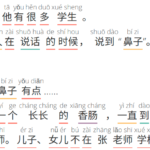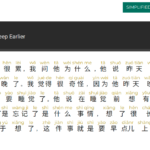
Learning to read Chinese is not a walk in the park. In fact, several factors make learning to read Chinese considerably harder than other languages. This doesn’t mean that it’s impossible, though, it just means that you need to find ways to meet those challenges. And of course, the best way to learn to read Chinese is to read more Chinese! Let’s have a look at the best Chinese reading practice resources for beginners! If you’re not a beginner, you should check out this article with Chinese reading practice recommendations for all levels.
Tune in to the Hacking Chinese Podcast to listen to this article:
Available on Apple Podcasts, Google Podcasts, Overcast, Spotify, YouTube and many other platforms!
6 challenges students face when learning to read Chinese and how to overcome them
Here’s a brief summary of the article linked to above if you don’t have time to read it (there’s a podcast episode too, though, so you can listen to it if you prefer):
- Challenge #1: Chinese is not alphabetic – In short, Chinese characters don’t represent sounds the way letters in an alphabet does. This means that you can’t use many of low-level reading skills you’ve acquired in other languages when learning to read Chinese. Thus, expect learning to take longer!
- Challenge #2: Understanding how Chinese characters work – There are several different types of characters, but most of them are compounds where one part indicates the sound and the other the meaning. These components themselves are simpler characters that usually started out as pictures.
- Challenge #3: Chinese reading is not an isolated skill – Reading ability comes more naturally if you have a foundation in the spoken language first, but in most courses and textbooks, you’re expected to learn to listen, speak, read and write all at the same time, which guarantees agonisingly slow progress.
- Challenge #4: Exposure and experience are important but elusive – In order to learn to read, you need to read a lot, but this is harder than it sounds for beginners, as texts you read will be too difficult and you’ll spend too much time struggling through challenging reading materials.
- Challenge #5: Reading is about more than the text itself – Even if you do understand the characters, words and grammar in a sentence, you might still not understand the intended meaning or message. This is normal. Reading of authentic texts requires deep cultural knowledge and relies on information outside of the text itself.
- Challenge #6: Authentic Chinese texts are hard – Text not specifically written for students will typically be much too difficult unless very carefully selected by a teacher. Even though it can be tempting to just try to power your way through authentic texts in this way, I strongly advise against it. Instead, stick to easier reading materials.
6 challenges students face when learning to read Chinese and how to overcome them
Finding suitable Chinese reading practice for beginners
For languages close to your own, diving into authentic texts can work, but it most certainly won’t for Chinese, or it at least it will be horribly inefficient. In fact, learners of Chinese spend way too much time reading way too little text. I mean that in the sense that much effort in spent on short, difficult texts, rather than more or longer texts at a more manageable level. You want as much extensive reading as possible.
The problem is that it’s not easy to find reading materials that qualify as extensive reading; it might be impossible as a beginner. Fortunately, this is not an either or situation, so even if you can’t find texts where you know 98% of the vocabulary, 95% is much better than 90% and even 80% is much better than 60%.
The more you understand, the better! The less you understand, the more you have to compensate by studying, looking things up and so on, which will take time and, at least for some students, be more tedious.
The 7 best Chinese reading practice resources for beginners
To help you out, I here present seven reading resources you can use to find appropriate reading material. These are not specific resources, but rather types of resources that you can use, but I will make sure to also give several examples with links so you can check them out for yourself.
I will try to provide free alternatives when possible, but paid resources will also be mentioned. If you have some money to invest, free products are not always the best option. If you only want free reading resources, I suggest you check this article: The 10 best free Chinese reading resources for beginner, intermediate and advanced learners.
The 10 best free Chinese reading resources for beginner, intermediate and advanced learners
Without further ado, here are the seven types of reading resources you can use to improve your Chinese reading ability as a beginner:
Chinese reading practice for beginners #1: Textbooks
Yes, I know, this sounds either obvious or stupid, but bear with me! Textbooks are written with beginners in mind, and entry-level textbooks are written for zero beginners. This means that they contain texts and dialogues that are as easy as possible and don’t require any prior knowledge to make sense of.
Sure, they become harder for each chapter, but there’s a way around that! Just use more than one textbook. If you read everything in chapter 1-5 in five different textbooks, you can be relatively sure that the reading will become easier and easier for each textbook you cover. While you can buy all these textbooks, you can also find many of them online.
Recommended Chinese textbooks for beginners
- Integrated Chinese (choose simplified or traditional characters; suitable for self-study)
- New Chinese Practical Reader (simplified or traditional characters)
- A Course in Contemporary Chinese (traditional characters; popular in Taiwan)
- Practical Audio-Visual Chinese (traditional characters; also focused on Taiwan, but older than the previous textbook)
- Easy Steps to Chinese (simplified characters)
Chinese reading practice for beginners #2: Graded readers
 These are books written with a specific level in mind, often measured in characters or words. The easiest graded readers start at around 150 characters and then go all the way up to thousands of characters. Graded readers are a great complement to textbooks, because they don’t become harder the more you read, they become easier!
These are books written with a specific level in mind, often measured in characters or words. The easiest graded readers start at around 150 characters and then go all the way up to thousands of characters. Graded readers are a great complement to textbooks, because they don’t become harder the more you read, they become easier!
They are also much, much longer than comparable texts and dialogues in textbooks, so you get to see the same characters and words over and over, which is great for that exposure and experience I mentioned above.
Recommended Chinese graded readers for beginners
- Mandarin Companion (especially the breakthrough level at only 150 characters, simplified or traditional); read my review here),
- Chinese Breeze (another series of books, starting at 300 words, simplified characters only)
- Sinolingua Rainbow Bridge (starting at 150 words, simplified only).
- More suggestions here.
Chinese reading practice for beginners #3: Reading apps
 There are many apps that aim to present you with reading materials on your level. Few of these control their vocabulary very tightly, so don’t expect “beginner” stories to only contain things you have learnt.
There are many apps that aim to present you with reading materials on your level. Few of these control their vocabulary very tightly, so don’t expect “beginner” stories to only contain things you have learnt.
Most of these apps present much shorter texts than the average graded reader and also come with numerous other features, such as pop-up dictionaries, recorded audio and more.
The short length makes them less daunting, but it also increases difficulty. Try to find texts you can read without relying too much on scaffolding tools.
Recommended Chinese reading apps for beginners
- DuChinese (smooth interface with free and paid content; use code HACKINGCHINESE for 10% off)
- The Chairman’s Bao (focusing on easy-to-read news)
- WordSwing (text adventure games at a slightly higher level; Escape! is free to play, learn more here).
- M Mandarin (I wrote a short review in the free reading article here)
Chinese reading practice for beginners #4: Vocabulary apps
 These apps don’t present you with reading material, but are instead focused on teaching you characters, words and sometimes grammar, which is of course necessary to be able to read.
These apps don’t present you with reading material, but are instead focused on teaching you characters, words and sometimes grammar, which is of course necessary to be able to read.
Ideally, you wouldn’t have to use apps like these very much, but since basic vocabulary is essential to even read at all, using them as supplementary tools to build and maintain a foundation of basic characters and words is useful.
Recommended Chinese vocabulary apps for beginners
- ChineseSkill (similar to Duolingo, but better suited to Chinese)
- Pleco (also the best dictionary you can find, flashcards are a paid add-on)
- Anki (free and very flexible; read my review here)
- Skritter (especially good for characters and handwriting, free and paid content; read my review here).
Chinese reading practice for beginners #5: Reading websites
 There are many sites and services that provide you with reading materials online and many of them are free, others have free sections you can access easily without registering.
There are many sites and services that provide you with reading materials online and many of them are free, others have free sections you can access easily without registering.
By combining several of these, the amount of free reading available can keep you occupied for quite a while! I reviewed each of those mentioned below in that other article I linked to earlier, so I will just provide the names here.
Recommended Chinese reading websites for beginners
- Mandarin Bean
- Chinese Reading and Comprehension
- Chinese at Ease
- Chinese reading practice (练读中文)
- Yes! Chinese (中文天下)
- My Chinese Reading
The 10 best free Chinese reading resources for beginner, intermediate and advanced learners
Chinese reading practice for beginners #6: Transcripts from beginner listening resources
 This is an indirect way to access even more reading while also focusing on your listening skills at the same time (you should always listen before you read, if you have the chance). The truth is that podcasts and other audio-based learning materials often provide transcripts that you can treat exactly as you would other texts.
This is an indirect way to access even more reading while also focusing on your listening skills at the same time (you should always listen before you read, if you have the chance). The truth is that podcasts and other audio-based learning materials often provide transcripts that you can treat exactly as you would other texts.
At a beginner level, there’s no big difference between formal, written Chinese and colloquial, spoken Chinese, so just go ahead and read the dialogues. When your Chinese gets better, transcripts of real conversations will of course be different from Chinese written with a reading audience in mind, but don’t worry about that now!
Please note that many podcasts offer their episodes for free, but charge for supplementary materials such as transcripts. Thus, try to find one that you like and consider paying for it, or if you can’t do that, stick to the other resources mentioned in this article!
Recommended Chinese podcasts with transcripts for beginners
- ChinesePod – One of the earliest podcasts for Chinese learners with an unrivalled library of lessons. Access to transcripts requires a premium subscription. If you only want to pay for one resource, this is the one.
- iMandarinPod – This podcast has transcripts directly available online. Here’s a direct link to episodes tagged as “elementary”, the lowest level. This will still not be easy if you just started out, though.
- Chillchat – This podcast is free to listen to, but you need to become a monthly supporter in order to get access to study notes and transcripts. If you like the audio episodes, consider using them for reading practice too.
For more listening resources for beginners, check out The 10 best free Chinese listening resources for beginner, intermediate and advanced learners:
The 10 best free Chinese listening resources for beginner, intermediate and advanced learners
Chinese reading practice for beginners #7: Interactive reading for beginners
 Don’t forget that the purpose of language is to communicate with others, and that doing so can be great for both motivation and learning in general. You have several options here, depending on your situation.
Don’t forget that the purpose of language is to communicate with others, and that doing so can be great for both motivation and learning in general. You have several options here, depending on your situation.
- If you have friends who speak Chinese, start text chatting with them. They will know that you’re a beginner, so will naturally adjust their language, and if they don’t, gently ask them to. Not all native speakers are good at this, and some of them might not be interested, but it doesn’t hurt to try!
- Start a language exchange with a native speaker who wants to learn a language you speak, which guarantees that you have a shared interest, and that you don’t need to worry about wasting the other person’s time. Obviously, to count as reading practice, this exchange should be partly or completely in writing. You can try apps like HelloTalk for this.
- If you have the means to do so, hire a tutor to chat with. It only takes a few minutes occasionally for them to keep a conversation going, but it can provide you with great reading practice. Once they get to know you, they will also know your level and be able to adjust to it. Tell them that you don’t really want to learn more words, but that you’d like to practise as much as possible using the vocabulary you already know.
Conclusion: Read as much as you can at your current level
As we have seen, the goal should be to read as much as possible. The only way to do that is to focus on texts that you can make sense of while only looking up characters and words occasionally. If you just started learning, it will be hard to find such texts, but do your best and try to find those that are as close to your level as possible! The better your Chinese becomes, the easier it will be to find texts that are both easy and enjoyable to read.
I’m not necessarily saying that you should only do extensive reading and never challenge yourself by reading harder texts; by all means do so occasionally! This is what most students are forced to do in class every lesson, though, so the most common situation is that students only do intensive reading, which is backwards.
If you find your self in such a situation, do your best to find reading materials on your own and practise extensive reading outside the classroom! Your Chinese will benefit immensely from it and you’ll have more fun along the way too!
In this article, I’ve done my best to provide you with beginner-friendly reading materials. What’s your favourite? Do you maybe know a resource I have overlooked? Please leave a comment below!
Want to read the companion article to this one about listening practice? Check here: Beginner Chinese listening practice: What to listen to and how
Beginner Chinese listening practice: What to listen to and how
Editor’s note: This article, originally from 2016, was rewritten from scratch in November 2021.


18 comments
Good write-up! I wasn’t aware of “Du Chinese”, seems like something I ought to check out.
As regards Mandarin Companion vs. Chinese Breeze, I’d say I find the latter to be better value for the money overall. Not only are the Chinese Breeze volumes cheaper, they also come with audio CDs (consisting of protection-free MP3-files) that are very good quality. I really wish the same was true for Mandarin Companion, because I agree that their stories are usually more engaging than Chinese Breeze’s.
With the shortage of graded readers available I guess I would recommend buying all the books from both of these series (as I have done myself), but if I had to choose one I’d go with Chinese Breeze because of the available audio CDs.
Good stuff.
Great collection! Decipher Chinese is pretty good for beginners, too. Looks similar to Du Chinese (which I haven’t tried yet), but it’s pleasant to use and they regularly add content.
What about the “Graded Chinese Reader” series?
https://www.amazon.com/s/ref=nb_sb_ss_c_0_21?url=search-alias%3Dstripbooks&field-keywords=graded+chinese+reader&sprefix=graded+chinese+reader%2Caps%2C261&rh=n%3A283155%2Ck%3Agraded+chinese+reader
I have read books of levels 1-3 of this series and I quite liked them. The texts are more advanced than those in the “Mandarin Companion” and “Chinese Breeze” series, which makes them a good choice for the transition from the beginner’s books to the authentic literature in Chinese. And BTW, all texts in the “Graded Chinese Reader” series are abridged versions of the authentic stories written by popular Chinese writers.
I wasn’t aware of that series, actually. I will contact the publisher and see if I can get some review copies. Thanks for the recommendation!
Hi everybody, thanks to this article I discovered “The Chairman’s Bao” which looks great… But I think their site is a bit misleading, isn’t it? I signed up (but didn’t subscribe) and received a “welcome email” explaining I now have access to all sorts of great features… Only I don’t! The “read more” button takes me back to the Home page and the App on my tablet keeps shutting down as soon as I try and open a new tab… Anybody else having difficulties with the website or the App? Or is it simply that they’ve made all their resources available only to subscribers? I would actually consider subscribing but given the glitches on the App, I don’t feel so confident… Will check out Du and the other suggestions here. Many thanks!
Hi!
I think it might be because they started charging for their content shortly after my article was published. I think charging for a service like this is reasonable, but it can always be discussed if they way they do it is good. Perhaps they’ve locked up too much content? In any case, my recommendation still stands, but I’ll add a note to the article about subscriptions. Thanks for pointing this out! Regarding your problem, I think the best way would be to contact their support. I’m interested in how this works out, so please report back if you can. 🙂
Update: I found this, perhaps related?
Best wishes,
Olle
Hi Olle,
“support” at Chairman’s Bao got back to me super quickly and they’re working on fixing the glitches. I agree with you, their offer is good and charging for it is reasonable and understandable.
I checked out Du Chinese, which looks quite good as well and is easy to use.
Thanks for your help and for all the good tips you share in your articles!
Thanks to this article I just started using Du Chinese and I have to say it’s a really great resource. Actually my reading is pretty good, however my tones are terrible (of the words I can read, I probably truly remember the tones of about 20% of them). Because the articles already have the tone marks it means I can sit and read an article aloud without having to check a dictionary to find the tone constantly. I think this can be a great help to slowly committing more and more tones to my long term memory.
Chinese Breeze now has two books of level 4 (1100 words).
I think hskreading.com is good for anyone who wants to find Chinese reading material. It provides English translations which really helps beginners understand the text. It doesn’t have Pinyin as default so it is hard at first but if you combine it with Anki it is great for learning Chinese.
One good resource for improve reading is Chinese Skill, is an app for learning Chinese in general, it has a lot of features like SRS, word reviews, etc, but also has a large collection of simple written lessons with audio, English translation, pinyin, etc.
For now, I am using https://www.chinesereadersguild.com/
I do think that it is an invaluable source of Chinese reading materials. Their articles have audio and full English translation. The thing I like the most from the website is that their articles cover so many topics: politics, medicals, K-pop, Chinese idioms, and even black holes!
PS: The website also has an Instagram account, which covers Chinese idioms. The account is @chinesereadersguild
I need to check that resource in more detail; thanks for the tip!
It is a shame that Chinese Breeze does not maintain their website. But in fact they now have four volumes at their Level 4 (1,100 words).
Thank your letting me know! This article is overdue for an update, and I will make sure to include a more thorough look at Chinese Breeze. I have in fact only read a few of their level 1 and level 2 books.
I find the graded readers from http://www.imagin8press.com delightful. Folktales for smaller vocabulary and The Journey to the West beginning with 600 word vocabulary. All the books have free audio on their website, read by good readers. I find some of the Mandarin Companion audio too robotic to be helpful, although the books themselves are good.
Thank you for bringing this up! They are on my radar, but I haven’t had time to actually read them yet. I think it’s great that they provide the audio for free (this is also common for some textbooks these days), which makes it a valuable listening resource as well.